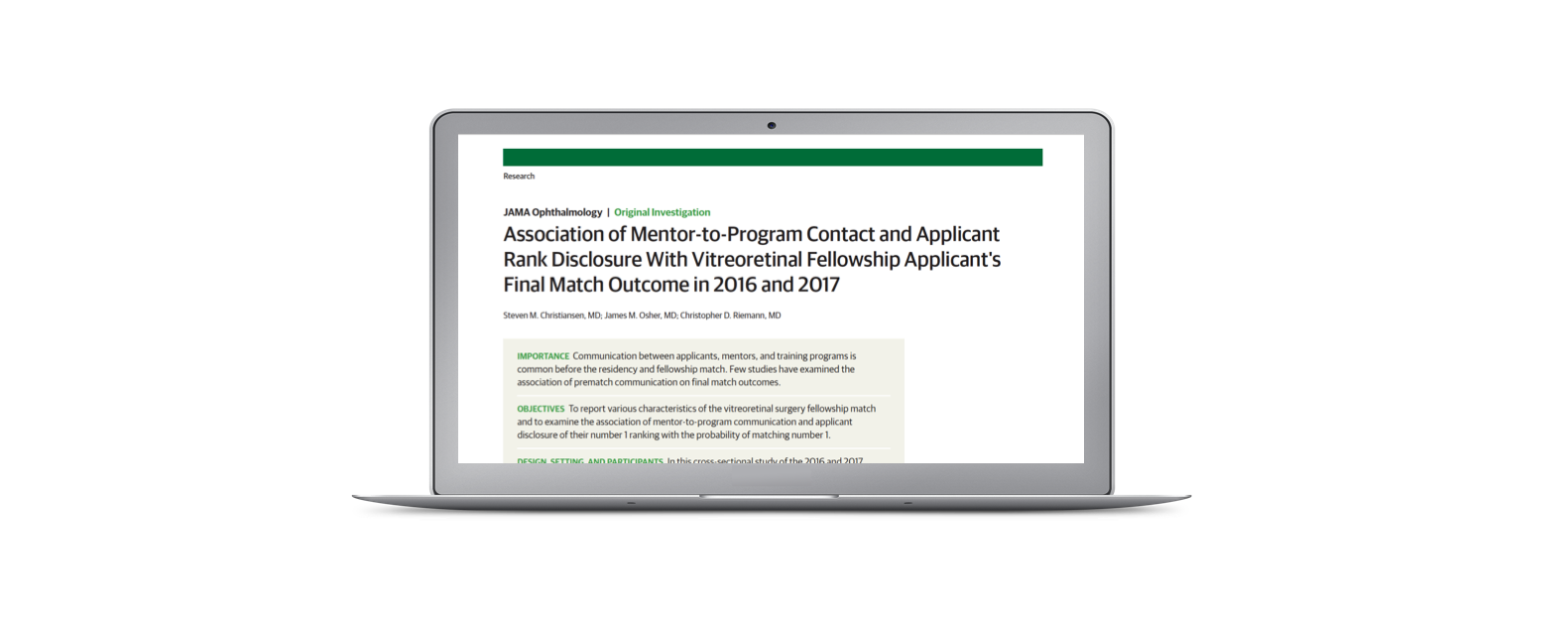The fellowship match process is somewhat of a mystery, and just a few years ago, I found myself in the middle of this mystery.
First came the application. To how many programs should I apply? What was an “average” number of applications? To how many programs could I expect/hope to be invited for an interview? How much would the whole process cost? When I applied for residency, I appreciated the article by Yousuf et al. describing the ophthalmology residency match outcomes, but was unable to find similar information for the vitreoretinal surgery fellowship match in the published literature nor on SFMatch.org.
Then came the questions about how to interact with my residency mentors in securing interviews at my most-desired surgical retina fellowship programs. Multiple people (including faculty at my program) had told me how important it was to have my mentors call programs on my behalf. I didn’t quite know how to navigate this, and I wondered if this was the “norm.” Was everyone having a mentor call for them? Did it really matter as much as everyone said it did?
Finally came the stress of how to communicate with programs AFTER the interview but BEFORE the match. Should I have a mentor communicate to my top programs my interest in matching there? Should I just tell them myself? Would any of this make a difference? And what were my chances of matching to my top few programs?
And the biggest question of them all – why was all of this such a mystery? Why wasn’t there more transparency to help applicants know how to navigate the match process?
Well, I am beyond thrilled to share that JAMA Ophthalmology just recently published my article: Association of Mentor-to-Program Contact and Applicant Rank Disclosure with Vitreoretinal Fellowship Applicant’s Final Match Outcome in 2016 and 2017.
My hope is that this article will help remove some of the mystery of the vitreoretinal surgery fellowship match, and help future applicants have a better idea of how to navigate the fellowship match.
Please read the full-text of the article for the most polished and peer-reviewed description of the research methods and findings. You can access the full PDF on the JAMA Ophthalmology website or on ResearchGate. (If you are unable to access the article using either of these formats, send me an email at steve@eyesteve.com).
Let me briefly summarize the most salient points from the study, with some editorial comments of my own..
Introduction
- The National Residency Matching Program (NRMP) and San Francisco Match (SF Match) are tasked with coordinating the residency and fellowship match. Both organizations have clear rules designed to protect applicants AND programs, including rules prohibiting requesting the other party reveal their match intentions. However, both applicants and programs may unilaterally disclose their own match intentions. If you have participated in the match, you surely recognize that this personal disclosure of ones ranking gives the other party a clear picture of your intentions and could potentially alter match outcomes. It is like showing the cards in your poker hand to one of your opponents before the final bets are placed. Not everyone knows what cards you hold, but that one opponent knows, and their knowing may change how they play their final hand, usually in such a way as to be to your benefit. It is like playing a game on the very game-theory upon which the match is founded. Several studies have examined both the integrity (or lack thereof) of the match, but no study (to my knowledge anyway) has clearly examined how an applicant disclosing their #1 rank may affect their chances of matching #1.
- No published data exists in the vitreoretinal surgery fellowship match literature, in any ophthalmology fellowship literature, or on SFMatch.org detailing the number of programs to which applicants applied and ranked, chances of matching to their top programs, the percentage of applicants who remain at their residency program for fellowship, what percentage match directly out of residency vs first doing fellowship (and the most popular fellowships completed before applying to VR surgery fellowship), and the gender breakdown of matched applicants.
- This study had several main objectives: to report various demographic and application-specific characteristics of the fellowship match and to examine how post-match communication and applicant rank disclosure may impact the final match outcome.
Methods
- I sent an anonymous online survey to all matched applicants in the 2016 and 2017 vitreoretinal surgery fellowship match. How was I able to obtain their contact info? I compiled a list of many of their names/email addresses while going through the match process in 2016, and used a similar list being shared among applicants in the 2017 match. This gave me a head start, but was far from comprehensive, so I then cross-referenced my list of who matched where with the official list of programs participating in the match posted on SFMatch.org to compile a list of ALL matched applicants, and where they matched. I then asked for help from other applicants, friends, former colleagues, and program coordinators/directors in helping me determine the names/email addresses of those still missing from my list. For a number of the programs, despite my best efforts, I was unable to determine if and whom they had matched, and several programs did not match a fellow (for reasons that were not always known, but may have included having gone unmatched, pulling out of the match early, not wanting to share the name of their future fellow, or other reasons.).
- All in all, the response rate to the survey was outstanding (77%), and I am quite confident that the survey results are a very representative sample of the overall study population. In 2016 I did not offer any incentive to survey participants, but at the suggestion of JAMA Ophthalmology reviewers, I did offer an incentive ($50 gift card) for the 2017 matched applicants surveyed.
Results
- The survey was sent to 198 matched fellowship applicants, and 152 (77%) completed the survey.
- Matched applicants applied to a mean (SD) of 34 (17) programs (range, 1-85) and ranked a mean (SD) of 12 (4) programs (range, 1-27).
- Out of the 152 applicants that responded to the survey, 66 (43%) matched at their number 1 ranked program, 23 (15%) matched number 2, and 21 (14%) matched number 3.
- The mean (SD) total cost was $5500 ($2776) (range, $500-$13 500).
- Of the 105 matched applicants in 2016, 21 (20%) were women. Of the 93 matched applicants in 2017, 24 (26%) were women.
- Two-sided χ2 testing found no association (odds ratio, 0.70; 95%CI, 0.34-1.4; P = .33) between mentor-to-program contact and the probability of applicants matching at their number 1 ranked program.
- Matched applicants who revealed their number 1 ranking either personally or via a mentor matched at a program ranked lower (more desirable) on their rank list (mean match ranking, 2.8) compared with those who did not reveal their number 1 ranking (mean match ranking, 4.2; 95%CI, 0.2-2.5; P = .01).
- Applicant disclosure of their intention to rank a program number 1, either personally or via a mentor, was associated with matching number 1 (odds ratio, 2.6; range, 1.1-6.0; P = .03).
Discussion
- Knowing the basic characteristics of the fellowship match is extremely helpful to fellowship applicants. This includes having an idea of how many applications “everyone else” is submitting, knowing how many interviews most applicants go on, and being able to have at least a ballpark estimate of how much the whole process may cost.
- 72% of applicants match in their top 3 of programs ranked. This is very similar to the official match outcomes published by SF match for ophthalmology residency positions (in 2016, 71% matched in their top 3, 1 – 39%, 2 – 19%, 3 – 13%) and to prior ophthalmology and NRMP matches.
- Vitreoretinal surgery, like ophthalmology in general, is gender disparate. We MUST improve this gender inequality and have a great opportunity to do so inasmuch as women now comprise over 50% of medical students.
- 74% of applicants who responded to the survey had a mentor contact a program on their behalf to express interest in that particular program, yet there was no association between applicants whose mentors made such contact and the probability of those applicants matching to their number 1 ranked program. This contact is so common that it is very nearly a requisite to the application. However, I’m not sure that these calls matter as much as we think they do, including the possibility that because “everyone is doing it,” it really doesn’t make that much of a difference, and just further muddies the water. On the other hand, because this contact is so ubiquitous, not having a mentor call may be akin to not submitting an aspect of the application, which clearly would not be a good idea. Simply calling/emailing on an applicant’s behalf may not make that much of a difference in the final match outcome, unless, however, the mentor tells the program the applicant intends to rank them #1.
- Applicant disclosure of their intention to rank a program #1, either personally or via a mentor rank, IS associated with the probability of that applicant matching number 1. Furthermore, applicants who disclose their #1 rank match lower (more desirable) on their rank list! This is a key finding from the paper, and hopefully provides important information to fellowship applicants in all specialties. Revealing your number 1 is the ultimate secret weapon to a successful match. You know you plan to rank that program #1, so what do you have to lose in telling them? Very little. In reality, you have a lot to gain. Multiple studies have shown that fellowship programs AND applicants adjust their rank lists based on such disclosures, but this is the first study to examine how that applicant rank disclosure impacts the final match outcome. Rank disclosure takes the guessing and uncertainty out of the match, and is completely within the rules of both the NRMP and SF match.
Conclusion
This study of the 2016 and 2017 matches provides characteristics of the vitreoretinal surgery fellowship match and suggests that applicants who disclose their number 1 ranking, either personally or via a mentor, experience improved match outcomes compared with their cohorts who do not make such disclosures.
Final thoughts
I am very excited that JAMA Ophthalmology has published the results of this fellowship match survey and hope that it takes some of the mystery out of the fellowship match. I am very appreciative to my fellowship mentors and co-authors, James M. Osher and Christopher D. Riemann at the Cincinnati Eye Institute, and most importantly, to the MANY matched applicants from the 2016 and 2017 match cycles for participating in the survey. I hope that future applicants will find the information from this study to be helpful as they prepare for and navigate the fellowship match process, and that the survey becomes an important contribution to the ophthalmology literature.
Once again, this is just a very short summary of the findings in this paper. Please read the full peer-reviewed article published on JAMA Ophthalmology for the complete introduction, methods, results, and discussion (including limitations of the study, of which there are several).
What do you think? Would this information have been helpful to you when you applied? To any readers that may be fellowship faculty, what are your thoughts? Could the findings from study be applied to other ophthalmology fellowships and/or to other fields in medicine, why or why not? I would love to get your feedback and engage in a healthy discussion, so please let me know what you think!



